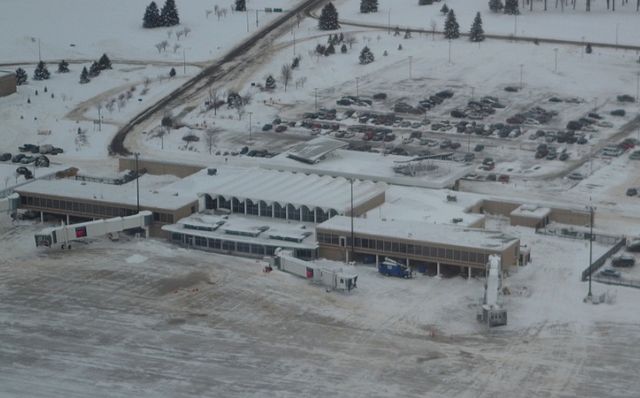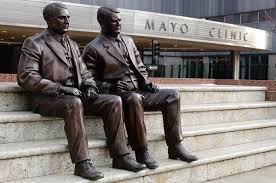MY PERSONAL FAVORITE WORLDWIDE DESTINATION
(Reprinted by the Post Bulletin Rochester, Minnesota)
Originally Appearing in


As the Fokker 110 landed on the barren runway in a light snowstorm, it appeared I finally arrived in Siberia. There was one other plane on the ground. The dark gravel runway was nearly invisible as the plane finally slowed on the ice and pulled up gingerly to the gate.
The wind chill of 30 below hit me as I stepped out of the small terminal to get into the beat-up taxi for the ride into town.
This was not Siberia. It was Rochester, Minn., a city of 75,000 souls in the southeastern corner of the state. I had arrived in town with my best friend.

There is little reason, on the surface, to imagine that this small city in Olmsted County set amid the rolling farmlands of the Zumbro River Valley would attract much attention. Little reason that a casual observer would be able to explain the presence of so many serious-minded young men and women in clean white shirts and blouses, wearing unusually practical watches and comfortable shoes among the 23 passengers on the small jet from Chicago.
Why were these people so intense; why did they read serious tomes instead of People magazine to pass the time aboard the plane? Why were they taking notes and why the friendly smiles at one another as they left the plane, pausing for a moment of recognition?
My fellow passengers seemed a rather international group — there were many representatives of a good many cultures among our small band of travelers.
I didn’t have a lot of time to think about this further since my taxi driver was a talker. He had longish hair and wore a deer hunter’s cap and a well-worn black-and-white-checked wool jacket.
“First time in Rochester?”
“Yes it is,” we replied. “What do we need to know about the town?”
“Well the winters are great, that is if you’re interested in snowmobiling like I am. Just got a new Kawasaki and I’m gonna open ‘er up soon as I finish this run. We don’t have a lot going on, no crime or nothing, although last Wednesday a fella held up a convenience store downtown. He pretended he had a gun, but the cops think he was just holding his finger inside his coat pocket. Still it was a pretty big deal up here. So besides snowmobiling we’ve got ice hockey. Then there’s IBM, they’re a major employer here, and of course, we got a hospital.”
The “hospital” they got, as a result of ironies of geography, was named after a small clinic run by a local doctor and his two sons. Their names were Mayo.
The Mayo Clinic represents hope for those who have reason to have lost it. The hospital appears in the dreams and prayers of the sick in the untidy, forgotten little corners of the world. To land, to make it, to the small airport in pretty much the middle of nowhere Minnesota, is to walk the yellow brick road of medicine.
My best friend came here seeking hope for a tumor that was said to be inoperable. But the gentle people who work medicine in the Minnesota winter don’t easily admit to defeat. If there is a way they will do it — and often they do it even when a way does not exist. Yes, the driver was right. The town has a hospital.
Just before depositing us at the Radisson Hotel, he asked me if I’d like to join him snowmobiling. I got out of the cab thinking about how kind an offer it was but I shook it off. I’ve lived in New York City. You don’t get to me that easily.
In the hotel, the bellman asked me if there was any place I needed to be driven. It was cold outside; he didn’t want me to have to walk and had noticed I didn’t have a rental car. A few minutes after check-in, an assistant manager called my room to see if I needed anything. When I walked downstairs, two hotel employees offered to show me how to get to the walking tunnels that connect underneath this small city in the snow.
Later, the waitress at Michael’s, Rochester’s most respected fine dining emporium, was so solicitous of our well-being that I thought she must be a Mayo nurse on the side. I was beginning to feel as though I was the first visitor the town had ever had. But wait a minute; the Mayo Clinic must have hundreds of thousands of visitors a year. What’s going on here?
The next day, Sunday, my best friend and I set out for a small church on a residential street in a lovely neighborhood of tree-shaded lanes. The temperature was near zero; there was a light wind and bone-chilling cold. It might have been smarter to stay warm inside, but we had to walk a few blocks to reach the church.
The service had already started as we settled into a pew in the back. I looked up, as I often do in churches, not so much in search of a spiritual experience as to inspect the work of the architect.
Suddenly the priest, Father Nick, was standing not very far from our seats in the back. It is, we discovered, his habit to walk into the middle of the congregation to deliver his sermon. This is a bit unsettling at first, particularly given the fact that the priest very much resembles the actor John Malkovich. Perhaps more eerie is the fact that he sounds just like him as well.
As the service concluded and my friend shook Father Nick’s hand the priest held on for a moment and said, “You’re here for surgery, aren’t you?” and then he whispered, “I want you to stay so I can say a prayer just for you.”
We did and he did. The prayer was nondenominational, almost poetic. It spoke of medicine and doctors with healing hands. It was just right. And then he smiled and said, “Now you must come downstairs to meet my family.”
We went downstairs, smack into the center of a social gathering that bespoke all of the truisms one hears about Midwest values. Strangers came up to us and for the next hour or so, we tried to speak with as many people as we could. There was the fellow from IBM, worried about the possibility of more Big Blue layoffs but optimistic that he’d “make it without having to leave town.” There was the Caterpillar equipment salesman who wanted us to come out to the house for a visit.
We were just a couple of strangers, among many that must pass through this town in any given week. But we felt very special because we realized that we had stumbled onto something out here in the frozen tundra. For a few moments, it was easy to forget that we were still just 90 minutes away from the biggest shopping mall in America.
We were among the last to leave the church basement. A woman, we noticed, had lingered, hovering near the doorway. She had noticed that we were walking and had waited for more than an hour to offer us a ride back to wherever we were going.
In 1993, Money magazine named Rochester as the best place to live in the United States. The magazine chose Rochester over every other city in the country because of a “humming economy, a crime rate among the nation’s lowest, little pollution and affordable housing.” The report also mentioned the town’s “superior medical care.”
But I’ve been to Rochester and I think Money magazine may have missed the mark. Rochester is a truly special place because of the character and the kind nature of the people who live there.
The next day, my best friend’s surgeon, the doctor who literally “wrote the book” on his area of specialty, arrived in my best friends room, followed by subordinates and doctors in training. Dr. Lee was a, meticulous gentleman, with white hair and a regal manner. He said hello to my best friend and then signaled to me that he would like quiet. He then sat down at the small desk in the room and opened a thick file containing all of the medical records we had brought with us. He turned each page slowly, and he moved his forefinger under each word as he read. He read every word of every report. It took about forty minutes and everyone stood silently so as not to disturb him.
I knew what he was reading. He was reading that my best friend had gone through nine previous surgeries. The last several had said that her tumors were attached to organs in an impossible manner and were, therefore, inoperable. Twice the worlds “impossible” had been used. We watched as he moved his finger along the words, the lines, and the pages. We waited for him to turn to us to say that, yes, it was “impossible”.
But he didn’t do that. Instead, he closed the last of the file, took off his glasses, took a deep breath and walked over to my best friend’s bedside.
He stared into her eyes and said “you’ve had more surgeries than anyone should have to endure. We’re going to see if we can end your pain.”
Two days later, my best friend entered a surgical ward for the tenth time. Dr. Lee, aided by the department head, was personally going to do the operation, the one several other highly qualified surgeons had said could not be done.
Hours later, he called me from the operating room, speaking softly. “It went well”, he said, “she will fully recover and we got it all.”
“How” I blurted out, “how did you do it when everyone else said it couldn’t be done.”
There was a very long pause, and then he replied, “Richard, we try not to bring folks up here to Rochester in the middle of winter without doing what needs to be done.”
That’s what you call “Rochester style.” These folks don’t brag. They just do what “needs to be done.”
The next morning I sat for a few minutes in the main waiting room looking at all of the other people whose “best friends” would soon have their lives entrusted to these folks from Rochester. I wanted to share some hope that their surgical outcomes would be as unexpected and wonderful as ours. I looked up and I saw a huge banner across the long wall in the entryway. It read:
“Physicians whose primary purpose in the practice of medicine is personal enrichment are not welcome in this institution.”
That sign was also “Rochester Style.” Five days later we flew the Fokker 100 home. The next week we went to see our family doctor for a check-up. Our doctor asked us if we could let him have the original copy of the surgery order signed by Dr. Lee. We said, of course, and asked if there were any other records of our visit to Rochester that he needed.”
“Oh, I don’t need the hospital records, I’ve got those”, he replied, “I’d just like to have this fellow’s autograph. You have no idea who he is.”
My best friend is fully recovered. We recently celebrated our 30th wedding anniversary.
Because I am fortunate enough to be able to travel the world and write about it for a living, I am often asked what is my favorite place on earth. I know that those who ask expect me to respond, with Provence, Bhutan, or, perhaps, some hidden portion of Patagonia.
But the honest answer to the question is that my favorite destination on this planet is Rochester, Minnesota, where they have snowmobiling and ice hockey, some decent brats, an IBM plant, and, oh yes, they have a hospital.

